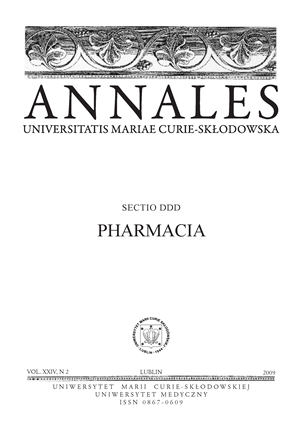Activity of testicular lysosomal enzymes in the courseof experimental diabetes in rabbits
DOI:
https://doi.org/10.2478/v10080-008-0191-xAbstract
Diabetes mellitus is a syndrome of disordered metabolism, usually due to a combination of hereditary and environmental causes. One of its complications is male infertility and endocrine dysfunction, including abnormality of the testosterone level. The aim of the study was to evaluate the activity of selected lysosomal enzymes in rabbit testis. Mature male New Zealand rabbits were randomly selected into a control and the experimental groups in which diabetes was developed by the intravenous injection of alloxan. Animals were sacrifi ced and the testicles were removed during autopsy done on days 21, 42, 90 and 180. The activity of the bound and free fraction of acid phosphatase, beta-galactosidase, beta-N-acetyl-glucosaminidase (NAGL), cathepsin B, D and L, lipase, and sulphatase were determined spectrophotometrically in testicular homogenates. The activity of the bound fraction of NAGL, cathepsin and lipase was increased on day 21 of diabetes. On day 42 the activity of the bound fraction of NAGL, cathepsin B and sulphatase were signifi cantly decreased, while the activity of bound cathepsin D fraction was increased. Simultaneously, a signifi cant elevation of the free faction of acid phosphatase and cathepsin D was revealed. On day 90 a signifi cant increase of both fractions of cathepsin L was noted. No signifi cant changes of the evaluated lysosomal enzymes were found on the last day of the experiment. The obtained data suggest that diabetes mellitus alerts the activity of most studied lysosomal enzymes in rabbit testis. Such an effect may impair male fertility.
References
1. Barrett A. J.: Lysosomal enzymes. In: Dingle J. T. (ed) Lysosomes. North-Holland Publishing Co, Amsterdam 1972.
2. Beattie G. M. et al.: Acid beta-galactosidase: a developmentally regulated marker of endocrine cell precursors in the human fetal pancreas. J. Clin. Endocrinol. Metab., 78, 1232, 1994.
3. Bener A. et al.: Is male fertility associated with type 2 diabetes mellitus?. Int. Urol. Nephrol. 2009 – in press.
4. Burdan F. et al.: The activity and immunoexpression of cathepsin D in rat male reproductive organs. Folia Morphol., 65, 111, 2006.
5. Burdan F. et al.: Hepatic lysosomal enzymes activity and liver morphology after short-time omeprazole administration. Exp. Toxicol. Pathol., 53, 453, 2002.
6. Burlina A. B. et al.: Behaviour of some lysosomal enzymes in the plasma of insulin dependent diabetic patients during artificial pancreas treatment. Clin. Biochem., 20, 423, 1987.
7. Corona G. et al.: Why can patients with erectile dysfunction be considered lucky? The association with testosterone deficiency and metabolic syndrome. Aging Male, 11, 193, 2008.
8. Garcia-Pascual J. J. et al.: Enzymatic glycosidase activities in experimental obesity. Horm. Metab. Res., 24, 412, 1992.
9. Górska P.: Principles in laboratory animal research for experimental purposes. Med. Sci. Monit., 6, 171, 2000.
10. Kim S. T., Moley K. H.: Paternal effect on embryo quality in diabetic mice is related to poor sperm quality and associated with decreased glucose transporter expression. Reproduction, 136, 313, 2008.
11. La Vignera S. et al.: Andrological characterization of the patient with diabetes mellitus. Minerva Endocrinol., 34, 1, 2009.
12. Maciejewski R. et. al.: Changes of the ATPase, acid phosphatase and alkaline phosphatase reaction intensity in the parotid and submandibular glands of rabbits in experimental diabetes. Folia Histochem. Cytobiol., 37, 99, 1999.
13. Maciejewski R. et al.: Changes in the activities of pancreatic cathepsins D and L and acid phosphatase in the course of alloxan-induced diabetes mellitus in rabbit. Med. Sci. Res., 28, 113, 2000.
14. Maciejewski R. et. al.: Changes in pancreatic lysosomal enzymes activity as the potential factors leading to diabetic enteropathy. J. Physiol. Pharmacol., 52, 823, 2001.
15. Saad F., Gooren L.: The role of testosterone in the metabolic syndrome: a review. J. Steroid Biochem. Mol. Biol., 114, 40, 2009.
16. Shirneshan K. et al.: Directed overexpression of insulin in Leydig cells causes a progressive loss of germ cells. Mol. Cell Endocrinol., 295, 79, 2008.
17. Strawser L. D., Touster O.: The cellular processing of lysosomal enzymes and related proteins. Rev. Physiol. Biochem. Pharmacol., 87, 169, 1980.
18. Taczała S. et. al.: The activity of some lysosomal enzymes of the thymus in rabbits. Annales UMCS, Sect. D, 49, 87, 1994.
19. Tong P. C. et al.: Association of testosterone, insulin-like growth factor-I, and C-reactive protein with metabolic syndrome in Chinese middle-aged men with a family history of type 2 diabetes Med. Sci. Monit., 6, 171, 2000.
20. Wójtowicz Z. et. al.: The activity of lysosomal enzymes in visual cortex of rabbits during experimental diabetes. Folia Neuropathol., 33, 159, 1995.
21. Wójtowicz Z. et. al.: The activity of lysosomal enzymes of the basilar artery wall on rabbits of different breed. Annales UMCS, Sect. D, 49, 141, 1994.
22. Wójtowicz Z. et. al.: Lysosomal enzyme activity of internal and middle layers of renal arterial wall in rabbits. Annales UMCS, Sect. D, 53, 153, 1998.
23. Wójtowicz Z. et. al.: The activity of lysosomal enzymes of rabbits gingiva mucosa during induced experimental diabetes. Annales UMCS, Sect. D, 60, 369, 2005.
24. Wójtowicz Z. et al.: Hepatic lysosomal enzymes activity turning the course of the experimental diabetes in rabbit. Annales UMCS, Sect. D, 60, 908, 2005.
25. Wójtowicz Z. et al.: The activity of lysosomal enzymes of rabbit thyroid gland during induced experimental diabetes. Annales UMCS, Sect. D, 61, 748, 2006.
26. Wójtowicz Z. et al.: The activity of lysosomal enzymes of rabbit skeletal muscles during induced experimental diabetes. Annales UMCS, Sect. D, 60, 369, 2005.
Downloads
Published
Issue
Section
License
Copyright (c) 2009 Authors

This work is licensed under a Creative Commons Attribution-NonCommercial-NoDerivatives 3.0 Unported License.


